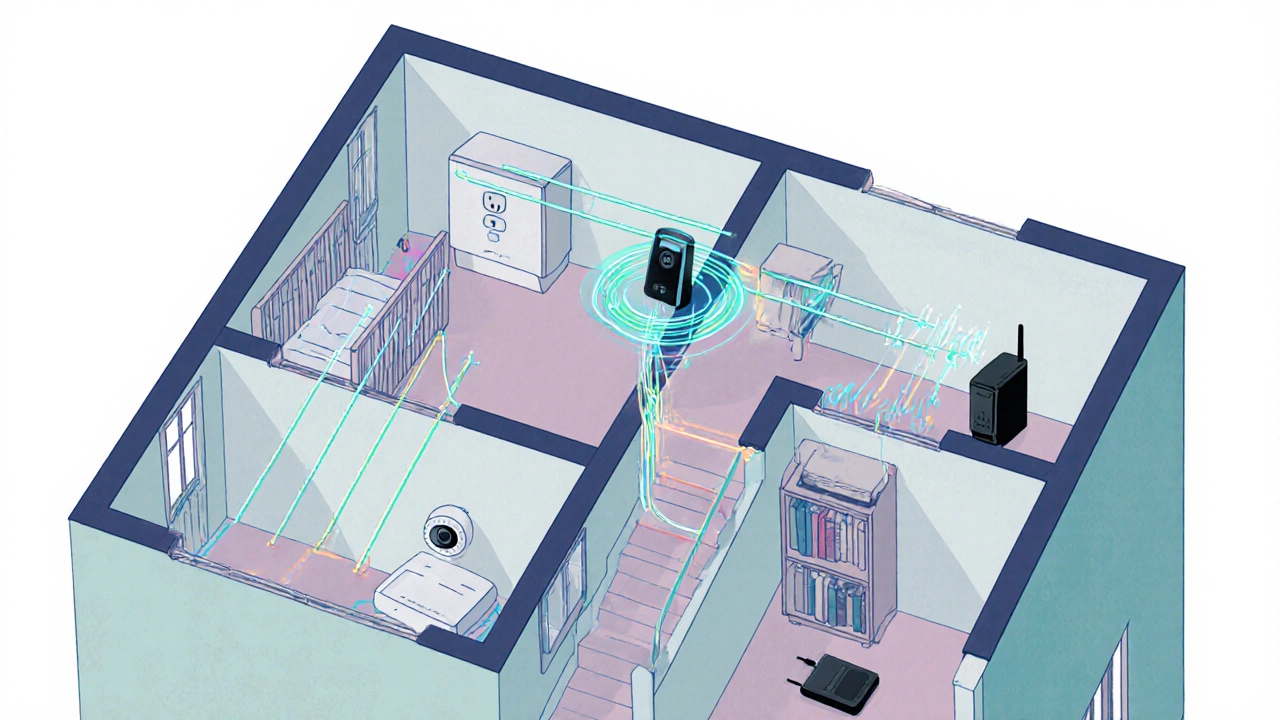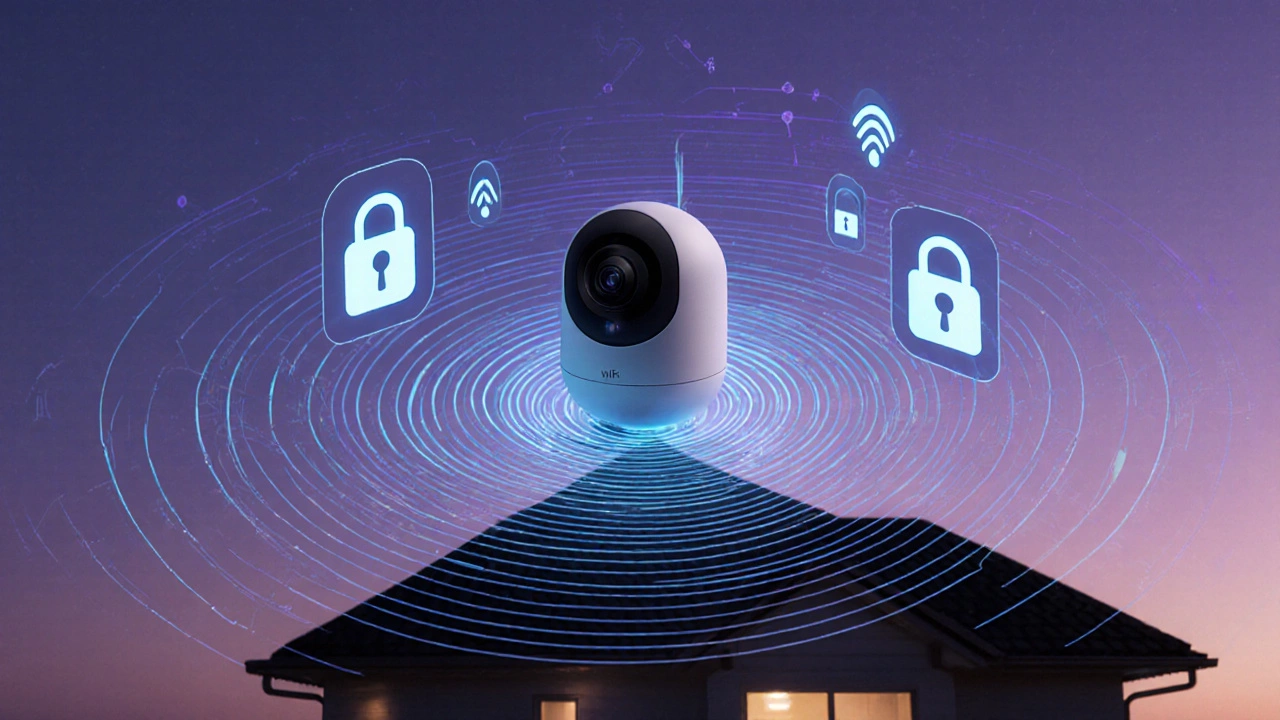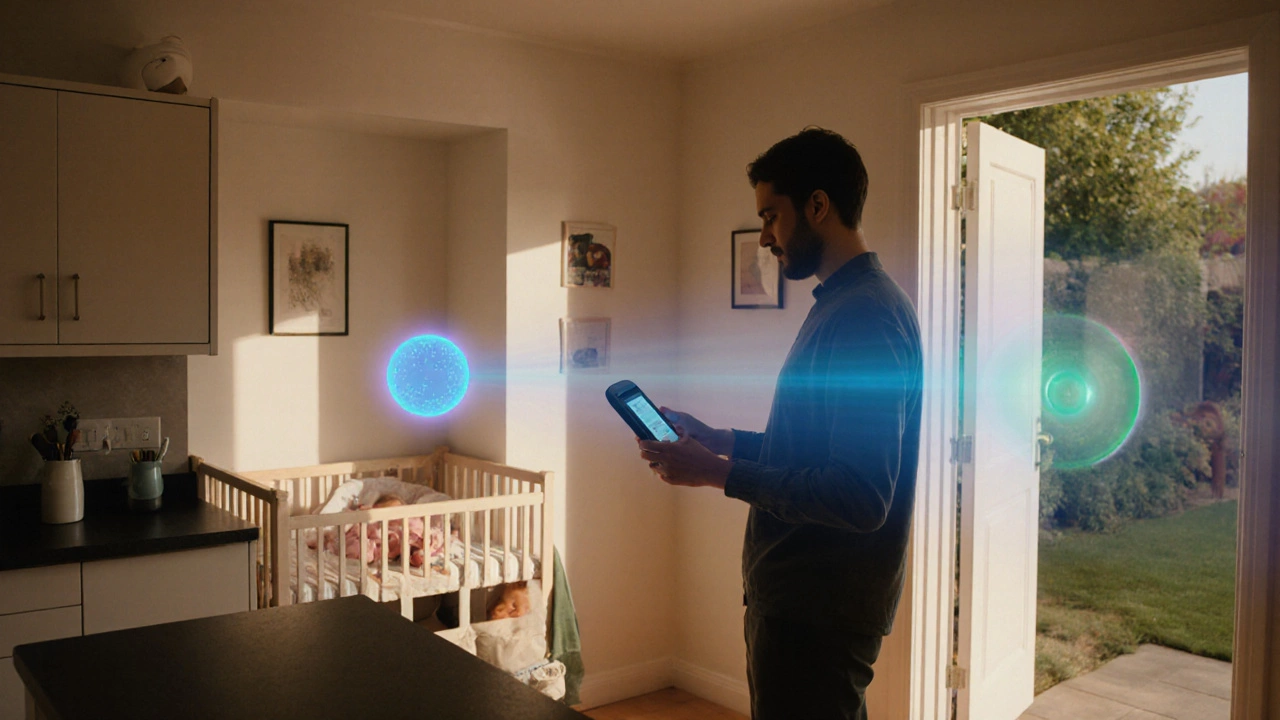Baby Monitor Range Calculator
Calculate Your Monitor's Range
Enter your monitor type and home layout to estimate maximum range
Estimated Range
Key Takeaways
- Typical audio monitors reach 150‑300m outdoors, 30‑100m indoors.
- Wi‑Fi video monitors can cover a whole house if the router is central, but walls and interference cut range.
- Bluetooth monitors are limited to about 10‑15m; use a Bluetooth hub for longer reach.
- Range extenders, powerline adapters, and mesh networks can push the signal an extra 50‑200m.
- Battery life, channel selection, and placement are the most common roadblocks to maximum distance.
When you buy a baby monitor is a wireless device that lets parents listen to or watch their infant from another room, the big question is how far it can actually reach. The answer isn’t a single number - it varies by technology, house layout, and the little quirks of radio waves. Below we break down the factors that decide your monitor’s range, show you how to stretch it further, and give a quick troubleshooting cheat‑sheet for when the signal drops.
What Determines a Baby Monitor’s Reach?
Four key elements shape the distance you can get out of a monitor:
- Transmission technology - audio only, Wi‑Fi, Bluetooth, or traditional RF each have a different baseline range.
- Frequency and power - 2.4GHz signals travel further than 5GHz, but are also more prone to interference.
- Physical environment - walls, doors, furniture, and even a concrete slab can cut a signal in half.
- Power source - battery‑run units often output less power than mains‑plugged ones, shrinking their range.
Understanding these pieces helps you decide which monitor fits your home and how to tweak the setup for maximum distance.
Technology Showdown: How Far Does Each Type Go?
Here’s a quick look at the most common monitor families and their real‑world reach.
| Type | Typical Indoor Range | Typical Outdoor Range | Battery Life (Camera) | Pros | Cons |
|---|---|---|---|---|---|
| Audio (RF 900MHz) | 30‑100m | 150‑300m | 6‑12months | Simple, low power, works without Wi‑Fi | No video, limited security features |
| Video (Wi‑Fi 2.4GHz) | 50‑100m (depends on router) | 200‑300m with line‑of‑sight | 4‑8hours (continuous), 24h on standby | Live video, two‑way talk, app integration | Sensitive to Wi‑Fi congestion, higher power draw |
| Bluetooth Low Energy | 10‑15m | - (not designed for outdoor) | 7‑14days | Very low power, easy pairing | Short range, needs a hub for farther rooms |
| Hybrid RF + Wi‑Fi | 70‑120m | 250‑350m | 5‑10hours | Best of both worlds, fallback when Wi‑Fi drops | More expensive, slightly larger unit |

Extending the Reach: Practical Tricks
If the out‑of‑the‑box range feels short, try these proven methods before you splurge on a new monitor.
- Re‑position the base and camera - keep both clear of thick walls and large metal appliances. A central location for the router (or monitor base) can add 20‑30m.
- Upgrade to a Mesh Network - placing a mesh node in the nursery bridges gaps and can double effective coverage.
- Plug a Powerline Adapter into a wall outlet near the monitor; the signal travels over your home’s electrical wiring, bypassing walls entirely.
- Use a dedicated Range Extender that repeats the monitor’s frequency; look for units that support the same band (e.g., 2.4GHz).
- Switch channels - most monitors let you choose a different frequency channel. Pick one with the least nearby Wi‑Fi networks to avoid interference.
- Reduce interference - cordless phones, microwave ovens, and baby‑care gadgets often share the 2.4GHz band. Turning off unused devices can improve range noticeably.
- Upgrade antenna - some models have detachable antennas; swapping a standard antenna for a high‑gain version can add 30‑50m.
When Range Becomes a Problem: Troubleshooting Checklist
Use this step‑by‑step list to pinpoint why your monitor’s signal is dropping.
- Confirm the monitor’s batteries are fresh; low power cuts transmission strength.
- Check the Wi‑Fi signal strength on a phone in the nursery. If it’s below 50%, move the router.
- Identify any new electronics that were installed nearby - a new fridge or smart thermostat can create radio noise.
- Swap the monitor’s channel; most units have a button or app setting for this.
- Test with a different monitor (if you have a spare). If the second unit works, the original may have a hardware fault.
- Run a quick Bluetooth scan from the parent unit. If the monitor shows up as “weak”, you’re hitting the Bluetooth limit.
Safety & Security: Why Range Matters Beyond Convenience
Longer range isn’t just about checking on a sleeping baby from the kitchen. It also affects:
- Data privacy - a weak signal may force a monitor to lower encryption, making it easier for outsiders to intercept.
- Battery safety - constantly boosting power to reach farther can heat batteries faster; keep an eye on temperature warnings.
- Legal limits - in Australia, the ACMA caps RF output for consumer devices at 10mW. Exceeding this can cause interference with other household devices.
Choosing a monitor with built‑in encryption (AES‑128 or higher) and staying within the manufacturer’s recommended range helps keep both your child and your data safe.

Choosing the Right Monitor for Your Space
Match the monitor type to your home’s layout:
- Apartments or studio homes - an audio or Bluetooth monitor usually suffices. Their short range isn’t a handicap when rooms are adjacent.
- Two‑story houses - a Wi‑Fi video monitor paired with a mesh router on each floor offers seamless coverage.
- Large properties with thick walls - consider a hybrid RF+Wi‑Fi model plus a powerline adapter in the farthest wing.
- Travel or temporary rooms - battery‑powered audio monitors are lightweight and have the longest independent range.
From the data in the table, a modern Wi‑Fi monitor can theoretically reach the entire house, but only if you mind the placement and mitigate interference. That’s the sweet spot for most modern parents who want video and two‑way talk without buying a separate range‑extending device.
Future‑Proofing: What to Expect in 2025‑2026
Manufacturers are rolling out monitors that use Wi‑Fi 6E (6GHz band) and AI‑driven motion detection. The higher frequency can carry more data, but it also has a shorter range - meaning you’ll see even clearer video at the cost of needing a stronger router or mesh setup. Keep an eye on models that advertise “extended range” through built‑in repeaters; they’ll likely replace separate extenders for most users.
Bottom Line
The short answer to “how far can you go with a baby monitor?” is: it depends. Audio monitors can push 300m outdoors; Wi‑Fi video monitors cover an average 100‑150m inside a typical home, and you can add another 50‑200m with a mesh node, powerline adapter, or range extender. The key is to match the technology to your floor plan, manage interference, and keep the monitor’s battery healthy. With a few tweaks, most families can reliably monitor their little one from any room - and even the backyard - without buying a brand‑new system.
Frequently Asked Questions
What is the typical indoor range of a Wi‑Fi baby monitor?
A Wi‑Fi monitor usually reaches 50‑100m indoors, but the exact distance depends on router placement, wall material, and signal interference.
Can I use a Bluetooth monitor in a two‑story house?
Bluetooth’s range tops out at about 10‑15m. To cover multiple floors you’d need a Bluetooth hub or switch to a different technology like Wi‑Fi or RF.
Do powerline adapters really improve monitor range?
Yes. Powerline adapters send the signal over your home’s electrical wiring, bypassing walls that would otherwise block RF. They can add 50‑150m of effective range.
How does interference affect my monitor’s distance?
Interference from Wi‑Fi routers, cordless phones, microwaves, or neighboring baby monitors can cut range by up to half. Switching channels or moving devices away from each other often restores performance.
Is it safe to run my monitor at maximum power all day?
Most monitors are designed to operate continuously at their rated power. However, prolonged high‑power transmission can heat batteries faster, so check for overheating warnings and replace batteries as needed.

